Navy Medicine II
The 6thBeachBattalion.org website is supported by host AlwaysOnline.net. The CEO of
AlwaysOnline, Mark L. Powell, is a 1983 U.S. Naval Academy graduate and retired Marine Corps officer. Mark's father
- "the person who influenced me most," - was a Shipfitter (SF) Second Class demolition specialist in platoon B-6 of the 6th Naval Beach Battalion. "Lawrence M. Powell was my father" Mark wrote. "He was orphaned at a young age, volunteered
for service in the U.S. Navy in 1942. He participated in 8 amphibious assaults, including H-Hour on Omaha Beach in
Normandy. His unit was directly at the spot where the first combat sequence of 'Saving Private Ryan' was reenacted.
If he could thrive after the challenges that he faced as a young man, my challenges are relatively inconsequential.
He and my mother were married for 49 years before he died in 1996." This is the official website of S1/c Larry
Powell's D-Day shipmates. The following is a reprint from the November-December 2000 "Navy Medicine" magazine, Vol.
91, No. 6, courtesy the Department of the Navy, Bureau of Medicine and Surgery (BuMed).
By Kenneth C. Davey
*****
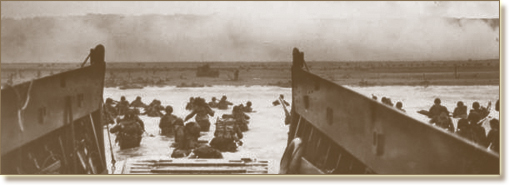
On June 6, 1994, half a century after the Allied invasion of Normandy, a U.S. Army D-Day veteran remarked that the
most horrendous invasion sight was a beach battalion bulldozer moving bodies to make roads off the Easy Red sector of
Omaha Beach. "A most heroic sight was that of a Navy Beachmaster calmly walking along the beach issuing orders through
a bullhorn." Several hours earlier, Beachmaster Joe Vaghi had used that powered megaphone to pass along the final
attack order, exhorting the 1st Division assault troops to capture the beach exits above Easy Red.
Army D-Day commanders on the invasion beach described the valor of the Navy bulldozer operator [SFC Merrill Whirty]
and the Beachmaster's entire battalion in a Proposed Unit Citation: "The extraordinary gallantry, heroism, and
determination displayed in overcoming unusual difficulties and hazardous conditions and the esprit de corps displayed
by the 6th Naval Beach Battalion contributed materially to the capture of Omaha Beach and reflect highest credit on
personnel of this organization and the Armed Forces of the United States." RADM Alan G. Kirk, Commander of the Western
Naval Task Force in France, recommended approval of the Unit Citation on 26 February 1945. For reasons unknown, the
battalion did not receive the award.
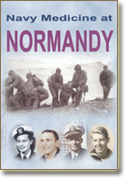
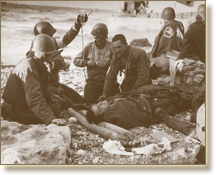
The 6th Naval Beach Battalion (NBB) began going ashore the invasion beaches of Normandy during the early morning hours
on D-Day, 6 June 1944. At H+65 minutes, approximately one hour after the first man stepped onto the beach, CDR Eugene
Carusi, Beachmaster Vaghi, a young Navy doctor, and 45 amphibious sailors of the battalion disembarked from the U.S.
Coast Guard-manned LCI(L) 88 - a Landing Craft Infantry (Large) - and struggled ashore the Easy Red sector of Omaha
Beach. As naval elements attached to the Army's 5th Engineer Special Brigade, the mission of these World War II
sailors was to prepare the beachhead, provide medical aid for the early wounded and keep men and materials moving
across the beach.
Once ashore, the 6th Naval Beach Battalion became the vital link between land and sea forces in the St.
Laurent-Colleville area of Normandy. The 400-man Navy battalion, composed of three companies, including three
platoons within each company, organized the Omaha landings in the invasion sectors code-named Easy Red, Fox Green and
Fox Red. The commander of each platoon was a Beachmaster, whose duties have often been described as similar to a
traffic cop at a busy intersection in hell. Utilizing hydrographic sailors for beach reconnaissance and demolition,
a communications section, boat repair specialists, a medical doctor, and Navy hospital corpsmen of the platoon, the
Beachmaster controlled all boat traffic coming onto the beach and arranged for the shore-to-ship evacuation of the
casualties.
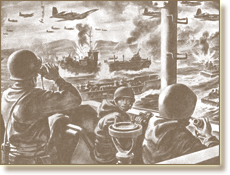
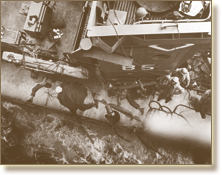
Unfortunately, not all of the Navy Beachmasters and their men made it ashore the Easy Red sector of Omaha Beach. At
approximately 0830 on the morning of D-Day, "We could hear the screams of men through the voice tube" reported LTJG
Coit T. Hendley, Jr., USCGR, commanding officer of LCI(L) 85. The '88's were hitting the ship. "The shells tore into
the troop compartments. They exploded on the exposed deck. They smashed through massed men trying to get down the
ramp. Machine guns opened up." The landing craft had been hit about 25 times, killing Beachmaster Jack Hagerty,
Beachmaster G. E. Wade, Assistant Beachmaster Len Lewis, Navy corpsmen, battalion radiomen, and Army combat
engineers. "Unloading of the Coast Guard-manned LCI 85 had to be stopped because the living could not climb over
the dead." The beach battalion doctors went to work, doing what they could for the wounded. "The deck was so slick
with blood and cluttered with bits of flesh and dead and mutilated men that it was difficult to move from one part
of the ship to another. There is no need to describe all the pitiful cases." No one will ever forget! "We had 15
dead and 30 wounded. Only four of the ship's crew were wounded. The other casualties were all from the beach
battalion."
The ship made it out to the transport area, 10 miles from the beach, taking water slowly. After transferring the
wounded to the USS Samuel Chase, Dr. John F. Kincaid and Navy medical corpsmen who stayed to help with the
casualties, climbed into a small boat. CDR Hendley reported that "they took their equipment and said nothing. They
knew they were needed on the beach. How many of them are living now I do not know." LCI(L) 85 went to the bottom
of the Channel. The casualty rate of the battalion's medical personnel was 27 percent and less than a year after
surviving "bloody Omaha,"
Dr. Kincaid was killed during a kamikaze attack off Okinawa. [invasion art by Ken Riley]
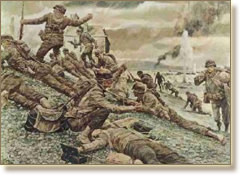
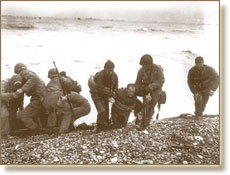
Meanwhile, in the cold Channel surf off Fox Green, 6th NBB corpsmen James S. Brewer and Thurman W. Poe disembarked
from an LCT (Landing Craft Tank) into deep water under heavy mortar fire. They were accompanied by a struggling Army
captain. When the captain's life belt failed and he was in grave danger of drowning, Poe and Brewer went to the
officer's rescue and brought him to the beach. Moments later, Eugene M. Riggleman of the battalion swam 50 yards
back out to sea under continuous enemy artillery fire against a strong tide to rescue a coxswain of an LCVP (Landing
Craft Vehicle and Personnel), which was disabled and sinking. "In spite of a direct hit on the craft while he was
aboard, he brought the man safely ashore." The three amphibious sailors were awarded the Marine Corps Medal.
Jerome Alberts in platoon A-3 of the battalion described the D-Day conditions over on "Fox Red" Omaha Beach.
"Thousands of mangled bodies were strewn about, and hundreds of others were in agony awaiting evacuation. The task
lay before us. Signal the Ships in! Stretcher bearers! Corpsmen! There was not an idle man. By noon, landing craft
and Rhino ferries were taking them to hospital ships. I take my hat off to the medics, both Army and Navy. The work
of Doctor Lee Parker, of our platoon, stands out in my mind. That man was everywhere and every place. One minute he
was ten feet from me giving a man plasma, five minutes later he was aboard a beached LCT, treating scores of other
wounded."
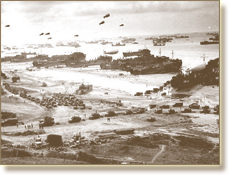
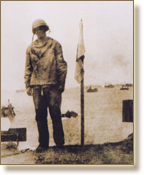
Because of the valor of Navy medical officers like Dr. Lee Parker [standing at his "Fox Red" Omaha Beach aid station],
more than 99 percent of the injured assault troops evacuated by the beach battalions in Normandy survived the
invasion. The mortality rate of the wounded reaching England was 3/10 of 1 percent. General Omar Bradley's First U.S.
Army Report of Operations concluded, "Combined training with the Navy Medical Department is a must. Too much cannot
be said about the part which the Navy played in the early days of the landing operation."
Official Army documents emphasize that during NEPTUNE, the amphibious assault phase of operation OVERLORD, the 6th NBB
not only managed to accomplish their own mission, but "aided many other units in the accomplishment of theirs."
Under near catastrophic conditions on "bloody Omaha," amphibious sailors of this naval battalion assumed combat
roles in support of the assault, demolished beach obstacles, marked sea lanes, established shore-to-ship
communications, directed the infantry landings, and provided medical aid and seaward evacuation for the many
wounded and dying young Americans.
 Back to Top
Back to Top














